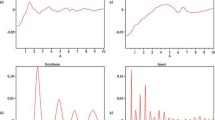Abstract
The standard mathematical models in population ecology assume that a population's growth rate is a function of its environment. In this paper we investigate an alternative proposal according to which the rate of change of the growth rate is a function of the environment and of environmental change. We focus on the philosophical issues involved in such a fundamental shift in theoretical assumptions, as well as on the explanations the two theories offer for some of the key data such as cyclic populations. We also discuss the relationship between this move in population ecology and a similar move from first-order to second-order differential equations championed by Galileo and Newton in celestial mechanics.
Similar content being viewed by others
References
Akaike H. 1973. Information theory and an extension of the maximum likelihood principle. In: Petrov B.N. and Csaki F. (eds), 2nd International Symposium on Information Theory. Akademiai Kiado, Budapest, pp. 267–281.
Akçakaya H.R., Ginzburg L.R., Slice D. and Slobodkin L.B. 1988. The theory of population dynamics—II: physiological delays. Bulletin of Mathematical Biology 50: 503–515.
Boyce W.E. and DiPrima R.C. 1986. Elementary Differential Equations and Boundary Value Problems. 4th edn. John Wiley, New York.
Cartwright N. 1999. The Dappled World: A Study of the Boundaries of Science. Cambridge University Press, Cambridge.
Clark G.P. 1971. The second derivative in population modelling. Ecology 52: 606–613.
Colyvan M. 2001. The Indispensability of Mathematics. Oxford University Press, New York.
Colyvan M. June-2001. The miracle of applied mathematics. Synthese 127: 265–278.
Forster M.R. and Sober E. 1994. How to tell when simpler, more unified, or less ad hoc theories will provide more accurate predictions. British Journal for the Philosophy of Science 45: 1–35.
Ginzburg L.R. 1972. The analogies of the “free motion” and “force” concepts in population theory, (in Russian). In: Ratner V.A. (ed.), Studies on Theoretical Genetics. Academy of Sciences of the USSR, Novosibirsk, pp. 65–85.
Ginzburg L.R. 1986. The theory of population dynamics I: back to first principles. Journal of Theoretical Biology 122: 385–399.
Ginzburg L.R. 1998. Inertial growth: population dynamics based on maternal effects. In: Mousseau T.A. and Fox C.W. (eds), Maternal Effects as Adaptions. Oxford University Press, Oxford, pp. 42–53.
Ginzburg L.R. and Colyvan M. 2004. Ecological Orbits: How Planets Move and Populations Grow. Oxford University Press, New York.
Ginzburg L.R. and Golenberg E.M. 1985. Lectures in Theoretical Population Biology. Prentice-Hall, Englewood Cliffs, New Jersey.
Ginzburg L.R. and Taneyhill D.E. 1994. Population cycles of forest Lepidoptera: a maternal effect hypothesis. Journal of Animal Ecology 63: 79–92.
Gotelli N.J. 1998. A Primer of Ecology. 2nd edn. Sinauer Associates, Sunderland, Massachusetts.
Kingsland S.E. 1985. Modelling Nature: Episodes in the History of Population Ecology. University of Chicago Press, Chicago.
May R.M. 1974. Stability and complexity in model ecosystems. 2nd edn. Princeton University Press, Princeton.
May R.M. and Oster G.T. 1976. Bifurcations and dynamic complexity in simple ecological models. American Naturalist 110: 573–599.
Mikkelson G.M. 2001. Complexity and Verisimilitude: Realism for Ecology. Biology and Philosophy 16: 533–546.
Rossiter M.C. 1996. Incidence and consequences of inherited environmental effects. Annual Reviews, Ecological and Systematics 27: 451–476.
Steiner M. 1998. The Applicability of Mathematics as a Philosophical Problem. Harvard University Press, Cambridge, Massachusetts.
Turchin P. 2001. Does population ecology have general laws? Oikos 94: 17–26.
Turchin P. 2003. Complex Population Dynamics: A Theoretical / Empirical Synthesis. Princeton University Press, Princeton.
Wigner E.P. 1960. The unreasonable effectiveness of mathematics in the natural sciences. Communications on Pure and Applied Mathematics 13: 1–14.
Wynne-Edwards V.C. 1986. Evolution through Group Selection. Blackwell, Oxford.
Yee J. 1980. A non-linear second-order population-model. Theoretical Population Biology 18: 175–191.
Author information
Authors and Affiliations
Rights and permissions
About this article
Cite this article
Colyvan, M., Ginzburg, L.R. The Galilean turn in population ecology. Biology & Philosophy 18, 401–414 (2003). https://doi.org/10.1023/A:1024121002194
Issue Date:
DOI: https://doi.org/10.1023/A:1024121002194




